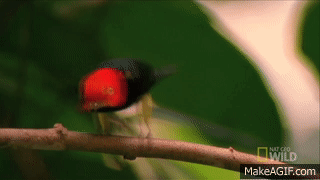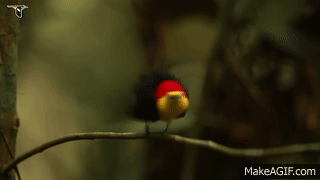
Manakin mania: the birds that dance with style
By Elizabeth Newton, Class of 2016
Have you ever heard of dancing manakins? No, not dancing mannequins.
Manakins are small birds found in the forests of South America. They’re special because many of them are great lookers, great dancers, or a combination of both. It’s the male that takes all the attention, for it is he that goes to great lengths to convince a female that he is a worthy father of her eggs. Courtship in manakins is something that needs to be seen to be believed. It varies greatly within the group, from the incredible moon-walking of the red-capped manakin (Ceratopipra mentalis), to the critically endangered araripe manakin (Antilophia bokermanni) defending a territory, attracting a female with calls, then wooing her with his spectacular hair.

Manakins are immediately appealing because of their charismatic dances, their gorgeous colours, and their engaging courtship. But why is it that these displays evolved in such variety in this one family of birds? There’s currently about 60 species in the manakin family (Pipridae), with almost as many unique plumage patterns and choreographies to match. It is thought that first of all, males were able to forgo helping females rear their young because of the abundance of fruit in their habitats. With so much food available for these frugivorous (fruit-eating) birds, only one parent is needed to provide the chicks with enough food, freeing up the male’s time to meet with more females.

From this point, males upped-the-anti on their attraction techniques, capitalising on their freedom to mate with many females, while at the same time competing against rival birds. Manakins display in what are known as leks: groups of males all vying for female attention within sight or ear shot of one another. This mass-displaying occurs because birds that could not get matings when displaying alone, have more success when they are nearby successful males.
One species of manakin takes lekking a step further. The blue manakin (Chiroxiphia caudata) puts on a mesmerising aerobatic display, enhanced by the help of his unrelated ‘apprentice’ males. What is the purpose of this co-operation? The lead male benefits from increasing the impact of his display, and it is him alone that always mates at the end. His apprentices meanwhile (2 to 6 in number) learn and practice important skills to ensure their own reproductive success. In fact, males that help out in these team efforts are more likely to secure rare matings on the side and also have a chance at inheriting the lead male’s patch and team as soon as the position becomes vacant.
A large team of blue manakins dazzling a female in a courtship that is co-operative, but only consummated by the dominant male.
As to why such variation in colour and dance exists between closely-related species, the answer is not particularly clear. Some argue that animals develop distinctive visual or auditory species ‘markers’ so that matings only occur between members of the same species and hybridisation is less likely to occur. Others say that the effect of environment is most influential in driving this divergence in dance and appearance. For example, differences in lighting between two regions may select for the birds which have the plumage most suited to courtship in those conditions. A third view is that it is all on the whim of the female’s internal selection criteria, which can be quite vulnerable to rapid change under some circumstances. It is likely that all of these factors come into play to varying extents.

So when you look at the huge diversity in male courtship in manakins, you realise that there’s even more going on than it appears from just watching them display. The reasons behind this explosion of unique dance moves makes a fascinating story, one that researchers are still puzzling out. To me, this amazing feat of evolution makes the manakin’s dances even more enjoyable!

Check out YouTube for really entertaining clips of dancing manakins (and you’ll get to hear their amazing wing-snapping too!). I’ll get you started: